Ps. I have in ISOTEK GII VISION on the power. Not noticed any choking effect with this, but neither an improvement. Just makes me feel safe it's in the mix ;-)
www.mouser.co.uk
Also, have a think about a simple 100R + 100p filter to pin 1 chassis on each of the inputs (pins 2 and 3)
Thanks SGK ...link might be broken? Home page of Mouser there 🙂
Yeah I figured you could use there search function with the part code you already have...
You could pick up the caps and resistors at the same time. 🙂
You could pick up the caps and resistors at the same time. 🙂
www.mouser.co.uk
Also, have a think about a simple 100R + 100p filter to pin 1 chassis on each of the inputs (pins 2 and 3)
SGK, this is to address any noise getting in through the XLR shields? Will that generally be audible? The amps are dead silent when turned on without any source. I cant hear anything even with my ears to the tweeter.
Are there any sources of distortion worth investigating?
I'm wondering if anything i have done with the modules has pushed its distortions up.
1. Can ventilation holes drilled on the case be source of EMI leakage
2. I had to splice the supply wires to connect a single SMPS600 to 2 NC400s, can the splice joint be a source of noise/distortion?
Gerrit,
I had the same issue with the Oppo and I ended up getting a $ 50 thingy that gets on the Oppo HDMI output, passes through the HDMI but extracts the digital stereo audio PCM from the stream.
The law says they are not allowed to send out the digital stereo from SACD, DVD etc, but it is on the HDMI out and can be simply extracted.
That works, so I CAN use the digital input of my digital xover.
Not saying it makes a lot of difference, but it is possible with this little gizmo.
BTW Your metal work looks professional. Did you do that yourself also?
Jan
Interesting. Does it work with DTS HD formats? The thing is I use the mix down capability of the oppo to mix the center and LFE with the main out.
The big pieces I had cut to size, all the angled profiles I did myself.
Hi Gerrit
Notice you are using OPPO direct - how do you find the high frequencies with nCore amplification so far?
Many thanks
Most excellent, but beware that I use a direct driven ribbon. The impedance of the 2Ω series resistor is extremely large compared to the 20mΩ or so of the ribbon, this means that were talking pure current drive without any electrical damping.
It's a distinct possibility that the low output impedance of the NCore is not an advantage when it comes to mid or high frequencies. If you need to attenuate the tweeter signal you could choose to do that after the amp. I did this for the Neo10 mids in my system. This way I don't loose any bits in the critical midrange.
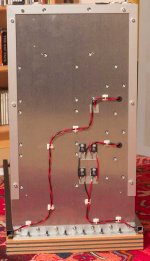
This is the bottom view of the amp with four 0.5Ω 100W Caddock film resitors for the ribbon and a 15Ω 50W Caddock resistor for the mid.
I also have RF input filters directly on the XLR chassis connectors and paid attention to proper shielding.
At my friend's place we compared the NCores to a The Fisher Sa1000 tube amp driving a set of Audiostatic Dci full-range electrostatic loudspeakers. We both immediately noticed the increase and tightening up of the low end when using the NCore, but as far as we could discern there was no difference with respect to mid and high frequencies.
regards,
Gerrit
SGK, this is to address any noise getting in through the XLR shields? Will that generally be audible?
It's a pretty standard EMC protection measure. Ti33er is trying to figure out something he finds audible.
1. Can ventilation holes drilled on the case be source of EMI leakage
I doubt it. Assuming your enclosure is connected to mains earth it creates a Faraday cage (albeit a steel enclosure would be better in this respect).
2. I had to splice the supply wires to connect a single SMPS600 to 2 NC400s, can the splice joint be a source of noise/distortion?
I doubt it.
I ended up deciding to chop the bottom off my speakers and build stands for them, mostly to save weight. But that gave me a great place for my amps instead of hanging a box on the back of each speaker.
Below is my first pass at designing the stands. I only have one SMPS and two NC400 modules per speaker right now but I would like to add more later this year so I made sure to allow for that.
It's all wood except for a 1/8" aluminum sheet below the amps and power supply, to give the amp modules a little more heat sink. I put a slot down low on the front and another up high on the back, with the hope that I'll get a little bit of chimney effect as the heat rises.
Everything will slide out like a drawer so I can easily access all wiring. Right now I have it drawn with a 1/8" aluminum panel at the back where the XLR and IEC connectors mount. But I'm not really sure if there's a good reason for making that piece aluminum.
Haven't decided what to do about speaker wires yet.
-Chris
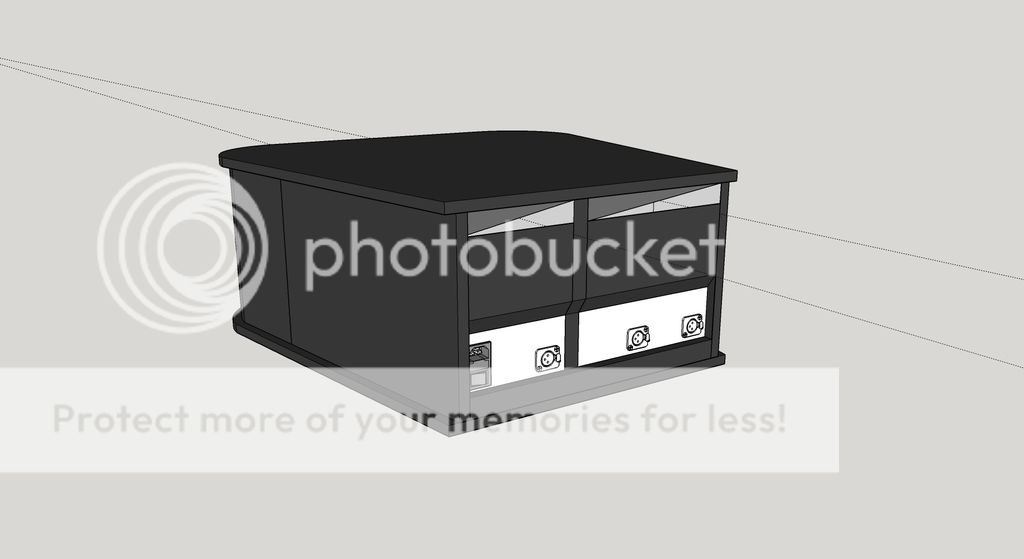
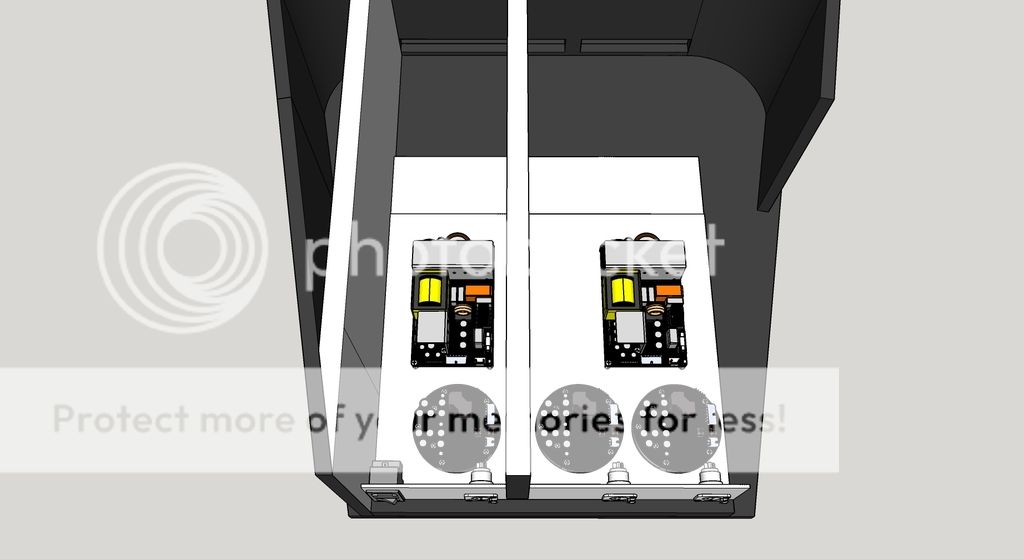
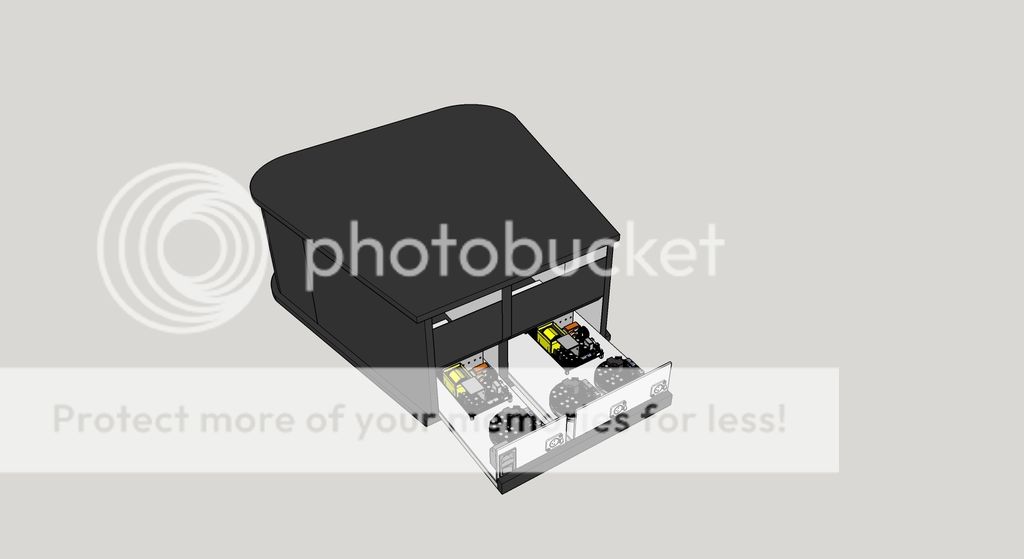
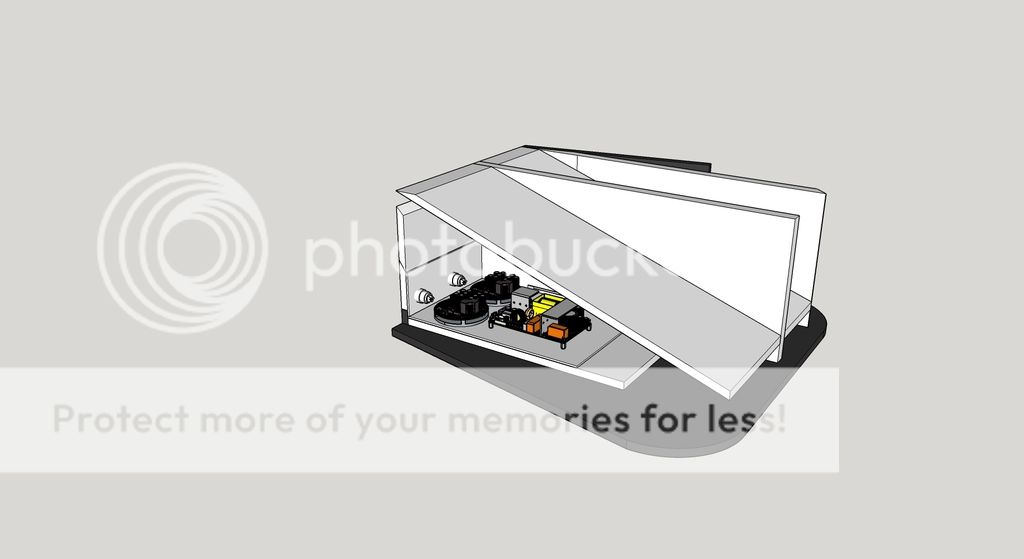
Below is my first pass at designing the stands. I only have one SMPS and two NC400 modules per speaker right now but I would like to add more later this year so I made sure to allow for that.
It's all wood except for a 1/8" aluminum sheet below the amps and power supply, to give the amp modules a little more heat sink. I put a slot down low on the front and another up high on the back, with the hope that I'll get a little bit of chimney effect as the heat rises.
Everything will slide out like a drawer so I can easily access all wiring. Right now I have it drawn with a 1/8" aluminum panel at the back where the XLR and IEC connectors mount. But I'm not really sure if there's a good reason for making that piece aluminum.
Haven't decided what to do about speaker wires yet.
-Chris




Hi Jojip
Treble is definitely more sandpapery sounding with my nCore than other amps I have...
I have been looking at this on eBay:
https://www.ebay.co.uk/itm/172096440934
Neutrik 3 Pin NC3MXX-EMC Male XLR Connector. Silver Connector, Gold Pins.
SGK recommended it be worth a try, these EMC XLRs...just in case some noise is getting in.
I was sold on the nCore after reading from various sources that these amps had Valve-like treble....it's the complete opposite in my experience this far :-(
I need to try this amp out of the case some time in case there are some RFI issues when close to aluminium (may not be an issue but I've come across people insisting on Plywood cases due to such issues with other equipment)
Thanks ti33er and SGK. I will put that on the list of things to try.
Planning to do a listening test with a friends Arcam AB amp this evening to investigate further.
Is that the power rating of a pair of bridged NC400 ??
Source was Bruno via post or email, forgot.
Last edited:
That sounds like the output power figures from the data sheet multiplied by 2, but shouldn't bridging quadruple the power instead of doubling it? And the minimum load will be 2 ohms, not 1 ohm, if bridged.
Specs via Bruno in either a post or email, forgot:
2x SMPS600 > 2x NC400BTL, 400/800/1200W @ 8/4/2 Ohm, 1 Ohm minimum. 2x 600W PS = 1200W maximum. Specs = 2x (1x SMPS > 1x NC400) and same minimum impedance (same 600W PS per NC400 module). I employ SMPS1200A400, same current as 2x SMPS600.
1x SMPS600 > 2x NC400BTL: 400/600W @ 8/4 Ohm, 2 Ohm minimum. PS limited to 600W total, and minimum impedance doubles.
Virtually positive Bruno somewhere stated 1x SMPS600 > 2x NC400: 200/300W @ 8/4 Ohm, 2 Ohm minimum. 1x 600W PS = 2x 300W maximum.
Last edited:
the technology tends to define the output impedance of the amp(s), it will be similar for both the single 400 and single 1200.
when you use an amp in a push-pull or bridged arrangement it doubles the output impedance the load sees. This may or may not be of consequence in an audible sense depending on the real world load seen.
Alan
when you use an amp in a push-pull or bridged arrangement it doubles the output impedance the load sees. This may or may not be of consequence in an audible sense depending on the real world load seen.
Alan
Specs via Bruno in either a post or email, forgot:
2x SMPS600 > 2x NC400BTL, 400/800/1200W @ 8/4/2 Ohm, 1 Ohm minimum.
This must be a typo: if one nc400+smps600 can output 400W @ 4 ohm, then two bridged nc400+smps600 will output 800W @ 8 ohm.
Since you double the voltageswing over e.g. a 4 ohm load, the output will also double. 400W @ 4 Ohm single ended makes 800W @ 4 Ohm BTL. Note that your gain increases by 6 dB.This must be a typo: if one nc400+smps600 can output 400W @ 4 ohm, then two bridged nc400+smps600 will output 800W @ 8 ohm.
SGK recommended it be worth a try, these EMC XLRs...just in case some noise is getting in.
I got them from here:
Neutrik NC3 MXX-EMC - Thomann UK
...they were not so simple to assemble as the regular XLRs, but hopefully worth it!
In Europe I think Thomann is the best vendor for Neutrik (XLR, speakons, powercons...).
Hi Tom4s
Are you using these EMC XLR on your nCore ?
Without being shot for not blind testing things 🙂 do you perceive any difference whatsoever?
Thanks
Are you using these EMC XLR on your nCore ?
Without being shot for not blind testing things 🙂 do you perceive any difference whatsoever?
Thanks
Typo again?Since you double the voltageswing over e.g. a 4 ohm load, the output will also double. 400W @ 4 Ohm single ended makes 800W @ 4 Ohm BTL. Note that your gain increases by 6 dB.
400W @ 4 Ohm single ended makes 800W @ 8 Ohm BTL
- Status
- Not open for further replies.
- Home
- Amplifiers
- Class D
- Hypex Ncore